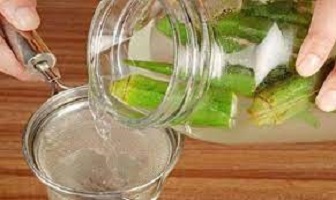Oha Leaves Benefits – What Does Oha Leaf Give To the Body
Oha Leaves Benefits – What Does Oha Leaf Give To the Body

How Oha Saves You from Toxins – Read on!
Oha leaves are the edible leaves of an evergreen tree found in Africa that is botanically known as Pterocarpus mildraedii.
“Oha” or “Ora” is the Igbo name while the English name is the African Rosewood plant. The plant is medicinal and grows into a huge tree that retains its green leaves throughout the year.
Oha leaf is frequently used in the preparation of soups and other delectable dishes. Aside from the flavor, it adds to foods, oha leaf is also used for its medicinal or health benefits.
Oha (ora) leaves are used to make oha soup, one of Nigeria’s most delicious soups. Cocoyam or achi, palm kernel oil, uziza leaves, and chicken can be used to make it.
In this write-up, you will learn about the nutrition content, benefits of oha leaves, and culinary uses of Oha leaf.
Oha Leaf Nutritional Value
As a vegetable, it is obvious that it contains many nutrients that are beneficial to the body.
It contains:
- Calcium
- Magnesium
- Iron
- Zinc
- Fiber
- Potassium
- Manganese
- Sodium
The leaf is also high in protein and contains vitamins A, B, and C
Fresh Oha leaves also contain other phytochemicals. An examination of various solvent extracts revealed the presence of alkaloids, saponins, glycosides, and tannins.
These phytochemicals are required for your cells to be protected from damage that could lead to chronic diseases.
Because potassium’s cations are important in neuron function, it regulates muscle and nerve activity.
It also aids in the maintenance of the body’s pH level
Sodium, on the other hand, aids in the balance of water, acids, and bases in the fluid outside the cell.
Iron is found in haemoglobin and mycoglobin. It is required for the transport of oxygen and carbon dioxide as well as oxidative phosphorylation.
Health benefits of oha leaves
Oha leaves benefits are discussed so that you can see how using the leaf in your cooking can benefit your body.
- Enhances Heart Health
Oha leaf also benefits your heart health.
It helps to prevent cholesterol buildup, which can be harmful to the heart.
Furthermore, sodium contributes to the balance of water, acids, and bases in the fluid outside the cell.
Oha is also high in iron, which is found in hemoglobin and mycoglobin. It is required for the transport of oxygen and carbon dioxide as well as oxidative phosphorylation.
Iron deficiency is bad for your heart.
Saponins can lower bad cholesterol in the body, according to a 2018 study. They are also hemolytic and anticoagulant, making them excellent for cardioprotection (6).
As a result, Oha will help reduce the risk of heart disease by using this compound.
- Encourages Healthy Digestion
Because of its high fiber content, including oha leaf in your cooking can help facilitate better digestion.
Fibre aids in the digestion of food, preventing constipation, irritable bowel syndrome, and other digestive issues.
It also promotes gut health, which helps to prevent colon cancer.
If you suffer from constipation on a regular basis, using oha leaf in your cooking would be extremely beneficial to your digestive system.
- Beneficial to Your Bones
Oha is a leaf that is extremely beneficial to your bones.
The presence of vitamin C in this vegetable indicates that the leaves could be used to promote healthy living.
It aids in the preservation of tissues, bones, and teeth. It also protects against scurvy and other diseases caused by ascorbic acid deficiency.
- Controls Blood Pressure
High blood pressure, also known as hypertension, is a leading cause of death. The disadvantage is that it rarely causes symptoms, implying that death occurs suddenly.
That is why it is recommended that you have regular checkups.
If a check-up reveals that you have high blood pressure, you can make dietary changes.
You can include the oha leaf, which is high in potassium and magnesium, two nutrients that help lower blood pressure by relaxing the blood vessels.
- Improve Liver and Kidney Health
The leaves are also said to have beneficial effects on the liver and kidneys.
One study looked at the effect of partially purified Pterocarpus mildbraedii extract subfractions on carbon tetrachloride-intoxicated rats. The study found that the sub-fractions repaired the rats’ damaged hepatic architecture.
Simply put, oha leaves may be beneficial in preventing or treating liver damage.
Two additional medical studies have attested to the beneficial effects of oha leaves on the liver.
Another study found that oha leaf extracts had a positive effect on the kidneys of rats.
Other oha leaf benefits include:
- It Improves Your Immune System
- It improves your vision
- It is n excellent source of antioxidants
- It increases the production of red blood cells
- Certain cancers are resistant to it.
- Improves Nerve and Muscle Function
- Could Help With Stomach Ulcer Healing
Oha leaf – Pesticides and Public Health
The majority of farmers use these chemicals, which contaminate your vegetables with toxins that are harmful to your health.
According to a 2018 study, pesticide exposure is a serious issue that causes various types of DNA damage, such as oxidative damage, which leads to various types of cancer.
Some of these cancers include brain, skin, lymphoma, breast, and others
Cancers of the pancreas, stomach, liver, bladder, and gall bladder are also possible outcomes.
It can also result in Parkinson’s disease, Alzheimer’s disease, and adverse reproductive outcomes.
According to the study, pesticide exposure has been linked to an increase in the incidence of non-lymphoma, Hodgkin’s multiple myeloma, soft tissue sarcoma, and lung sarcoma.
However, not every food you eat has the ability to flush out this toxin that causes oxidative stress.
This is where Oha leaf [Pterocarpus soyauxii], which can be used as a soup spice, comes in.
Oha Leaf and Skin Glow
Surprisingly, one of the things you will adore about Oha is its stunning appearance.
The leaf is simply stunning and gleaming, which speaks volumes about its ability to make your skin glow.
We don’t mean bleach when we say glow. Do not use it as a bleaching agent.
According to one study, saponins have antioxidant effects on the skin and protect it from UV damage
This is accomplished by inhibiting extracellular matrix degradation and acting as an antiirritant due to its anti-inflammatory properties.
Saponins may also be used to treat acne because of their antiseptic properties.
Is OHA leaf safe to consume during pregnancy? Oha leaf and Pregnancy
Oha leaves, on the other hand, contain dietary fibers that aid digestion, according to research.
As a result, a pregnant woman is less likely to experience constipation.
As you may be aware, digestive issues such as indigestion, belching, constipation, heartburn, and so on are common in pregnant women.
The Oha leaf has no negative effects on pregnant women or their unborn children.
Ora soup is high in iron, vitamin C, calcium, and folic acid, all of which are necessary during pregnancy.
Oha soup is recommended for pregnant women.
This vegetable which can be dried or fresh aids in the prevention of diabetes, cancer, cardiovascular disease, anemia, and bone disease.
It is especially beneficial to the elderly, pregnant women, diabetics, and young children.
Ora is a versatile food that is simple to incorporate into your diet.
How to Use Oha Leaf
To begin, keep in mind that most leaves should be consumed raw.
Boiling leaves usually degrades the nutrients, and Oha is one of the leaves that can be affected when cooked for an extended period of time.
As a result, our first choice is to blend it and drink it. . You can add it to your smoothie to power it up and get all of the nutrients in its raw form.
You can also get the nutrients by chewing the leaf.
Also, the most common way to consume Oha is to make soup with it.
How to Include Oha Leaf in Your Diet
Oha leaves are extremely versatile and can be used in a variety of recipes. There are two ways you can enjoy it:
Oha leaf tea
To make tea: Combine five or six oha leaves with a cup of boiled water. Allow for five minutes to steep and cool before drinking. You can sweeten it with honey or other ingredients.
Related >>>>
Oha leaves soup
Ingredients: Ora leaves, uziza leaves, cocoyam or achi powder, palm oil, assorted beef parts, dry fish, seasonings, pepper, and ogiri are among the ingredients
Oha leaf Recipe
Simply cook the assorted beef and stockfish in a pot until done.
Then, in the pot, combine the seasonings, cocoyam (thickener), and palm oil. Allow 10 minutes for it to cook.
Then, using your fingers, shred the leaves and add them to the boiling pot. Cook for an additional five minutes and your soup is done. It goes well with the wheat meal, fufu, or pounded yam.
Side effects that could occur
Although more human research is needed, oha leaves have shown no toxicity in animal models and are considered safe to consume.
However, remember to consume oha leaves in moderation; keep in mind that oha leaves may contain trace amounts of non-nutritional compounds such as oxalate.
Conclusion
Oha leaf is a nutritious, leafy-green vegetable that provides numerous health benefits.
This vegetable aids in the prevention of diabetes, cancer, cardiovascular disease, anemia, and bone disease.
It is especially beneficial to the elderly, pregnant women, diabetics, and young children.
Ora is a versatile food that is simple to incorporate into your diet.
Frequently Asked Questions
What is the English name for oha leaf?
Oha leaf (Pterocarpus mildbraedii) is a popular vegetable among Nigeria’s Igbos. The Igbo name is “Oha” or “Ora,” and the English name is African Rosewood plant.
What benefits does the oha leaf provide to the body?
Oha is a healthy vegetable. It has a high concentration of calcium, copper, zinc, magnesium, potassium, manganese, sodium, and iron.
The leaf is also high in protein and contains plenty of vitamins A and C.
Can I clean oha leaves?
Slice the uziza leaves and oha leaves, but not too thinly; better yet, tear the leaves with your hand.
Wash the uziza and oha leaves thoroughly with salt before adding them to the boiling stock.
Your delectable oha soup is now ready to be consumed with any swallow of your choosing.
Is oha leaf beneficial?
According to research, the Oha leaf is medicinal and keeps its greenish leaves all year.
It is high in iron, calcium, amino acids, iron, potassium, fiber, vitamin A and C, and other nutrients.
What are the advantages of oha leaf?
Oha leaf is a nutritious, leafy-green vegetable that provides numerous health benefits. This vegetable aids in the prevention of diabetes and cancer.
Is oha leaf beneficial to the heart?
The potassium mineral found in Oha (ora) leaves is necessary for regular heartbeat contraction.
African Rosewood leaves help the heart contract properly and effectively, allowing blood to flow to all parts of the body.
Is it safe for the eyes?
Oha leaves are high in vitamin A, which is thought to keep the eyes healthy, improve vision, and support a strong immune system.
Is there a substitute for oha leaf?
Oha (Ora) is a unique vegetable with no viable substitute.
What is oha soup made of?
Oha Soup is a delicious Soup recipe from Nigeria’s eastern region.
It’s one of those native Igbo soups that you can’t get enough of.
This hearty and nutritious soup is traditionally made with the leaves of the African Pterocarpus soyauxii/Pterocarpus mildbraedi tree, also known as Oha leaves.
Is oha leaf good for ulcers?
It improves digestion, lowering the risk of health conditions such as irritable bowel syndrome, constipation, and those caused by indigestion problems such as ulcers and gastroparesis (inability to empty the stomach properly).
What is OHA’s nutritional value?
Water 85 g, energy 237 kJ (57 kcal), protein 3.8 g, fat 0.8 g, carbohydrate 8.2 g, crude fiber 1.13 g, Ca 72 mg, Mg 28 mg, Fe 4.7 mg, and Zn 3.1 mg are the nutritional values of oha (Pterocarpus mildraedi).
How are oha leaves harvested?
According to old wives’ tales, cutting the leaves with a knife causes the leaves to turn bitter. It never becomes bitter, but the leaves are so tender that you don’t need a knife to cut them. The leaves are traditionally shredded with the tips of your fingers.
What exactly is OHA soup made of?
Oha Soup is a delicious Soup recipe from Nigeria’s eastern region. It’s one of those native Igbo soups that you can’t get enough of. This hearty and nutritious soup is typically made with the leaves of the African Pterocarpus soyauxii/Pterocarpus mildbraedi tree, also known as Oha leaves.
How to preserve oha leaves
- Pick the leaves, and then wash thoroughly. Allow draining any excess water before storage
- Store or package with plastic/Ziploc bag
- Lastly, store in the freezer
Fertility and the oha leaf ~ oha leaves and fertility
Oha leaf has no detrimental effects on pregnant women or their unborn children. Oha soup is high in iron, vitamin C, calcium, and folic acid, all of which are necessary for a healthy pregnancy.
Oha/ora soup is recommended for pregnant ladies.
Oha leaf and ulcer – Is Oha soup good for ulcers?
Egusi soup, ogbono soup, okra soup, Banga soup, black soup, Oha soup, vegetable soup, waterleaf soup, Ewedu soup, Afam soup, groundnut soup, and other Nigerian soups are beneficial to stomach ulcer patients.
What benefits does the oha leaf provide to the body?
Oha leaf is a healthy, leafy green vegetable with a lot of nutrients. Diabetes, cancer, heart disease, anemia, and bone disease can all be prevented by eating this vegetable.
The elderly, pregnant women, diabetics, and young children are all advised to take it. Ora is a versatile evergreen vegetable that is simple to incorporate into your diet.
Oha leaf in Yoruba ~ what is the oha leaf called in Yoruba
Actually, I’m not sure, do you? Please let me know in the comments section so that I can make the necessary changes.
Thank you very much.


